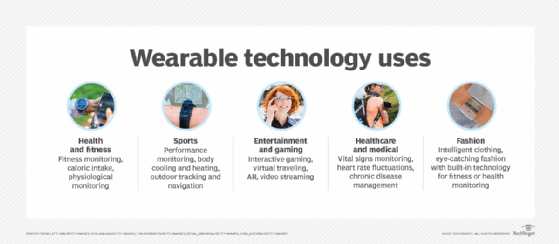What is wearable technology? Definition, uses and examples
Wearable technology is any kind of electronic device designed to be worn on the user's body. Such devices can take many different forms, including jewelry, accessories, medical devices, and clothing or elements of clothing. The term wearable computing implies processing or communications capabilities, but, in reality, the sophistication of such capabilities among wearables can vary.
The most advanced examples of wearable technology include artificial intelligence (AI) hearing aids, Meta Quest and Microsoft's HoloLens, a holographic computer in the form of a virtual reality (VR) headset. An example of a less complex form of wearable technology is a disposable skin patch with sensors that transmit patient data wirelessly to a control device in a healthcare facility.
How does wearable technology work?
Modern wearable technology falls under a broad spectrum of usability, including smartwatches, fitness trackers such as the Fitbit Charge, VR headsets, smart jewelry, web-enabled glasses and Bluetooth headsets. Wearables work differently, based on their intended use, such as health, fitness or entertainment. Most wearable technology contains microprocessors, batteries and internet connectivity so the collected data can be synced with other electronics, such as smartphones or laptops.
Wearables have embedded sensors that track bodily movements, provide biometric identification or assist with location tracking. For example, activity trackers or smartwatches -- the most common types of wearables -- come with a strap that wraps around the user's wrist to monitor their physical activities or vital signs throughout the day.
While most wearables are either worn on the body or attached to clothing, some function without any physical contact with the user. Cell phones, smart tags or computers can still be carried around and track user movements. Other wearables use remote smart sensors and accelerometers to track movements and speed, and some use optical sensors to measure heart rate or glucose levels. A common factor among these wearables is that they all monitor data in real time.
What are some applications of wearable technology?
Consumer electronics, such as smartwatches and fitness trackers, are prominent use cases for wearable technology. However, with the recent advancements in the internet of things (IoT) and AI, wearable technology is being incorporated into all types of environments -- including healthcare devices, navigation systems, consumer goods, professional sports and advanced textiles.

The following are the most popular current and next-generation applications of wearable technology:
Epidermal skin technology. According to ScienceDaily, the Terasaki Institute for Biomedical Innovation invented wearable "electronic skin" for monitoring health. A next-generation of wearables, this ultra-thin e-skin patch and a small wireless transmitter can be attached to the wearer's chest area by using water spray and can be worn for up to a week. It is sensitive enough to pick up and record electrical signals in the body, such as heartbeats and muscle movements, which can be sent to healthcare providers via the cloud so they can monitor the user's vitals remotely. This powerful wearable is a stepping stone for monitoring chronic illnesses such as heart failure and diabetes, as well as catastrophic events such as heart attacks.
Health monitoring. People use wearable technology to track and receive notifications about their heart rate and blood pressure, watch their calorie intake or manage their training regimens. The COVID-19 pandemic boosted the use of wearable technology, as consumers gained a broader awareness of personal hygiene and taking precautions to prevent the spread of infections. Cardiogram updated its watchOS app by introducing a new sleeping beats-per-minute feature that monitors heart rate fluctuations for COVID-19 patients.
Entertainment and gaming. The gaming and entertainment industries were the first to adopt VR headsets, smart glasses and controllers. Popular VR head-mounted displays, such as Meta Quest and Sony PlayStation VR, are used for all types of entertainment purposes, including gaming, watching movies and virtual traveling.
Fashion and smart clothing. Clothing known as smart clothing, or intelligent fashion, has gained popularity over the past few years. Smart jackets enable the wearer to activate their mobile device to answer calls, play music or take photos by touching a sensor right on their sleeves. Smartwatches, wristbands, smart shoes and smart jewelry like the Oura ring are other popular examples of wearable technology.
Military. These wearables include technology that tracks the vital signs of military service members, offer VR-based simulation exercises and support military operations and supplies, such as boot inserts that estimate how well the service members are holding their equipment weight and how terrain factors can affect their performance.
Sports and fitness. Sports teams use wearable athletic devices that are either built into the fabric of the sports apparel or are incorporated into sports equipment, such as bats and balls. The GPS- and Bluetooth-linked devices relay real-time data to coaches for analysis through connected electronic devices such as laptops. Besides wearable athletic devices, familiar wearable technology such as Fitbit, Apple Watch, Garmin watches, Samsung Galaxy Watch and Polar watches and sensors are used extensively to track various areas of the player's health and performance metrics.
Examples of wearable technology
Common examples of wearable technology include the following:
- Smart jewelry. This can include smart rings, wristbands and watches. Smaller wearable devices typically work with a smartphone app for display and interaction.
- Body-mounted sensors. These sensors are placed on the body to monitor and transmit biological data for healthcare purposes.
- Fitness trackers. These wearables often come in the form of wristbands, straps or headbands that monitor physical activity and vital signs. Trackers may connect wirelessly to an app for data storage, processing and reporting.
- Smart clothing. This type of clothing comes with built-in technology that can perform various tasks, including fitness or health monitoring, interacting with phones and other devices and changing fabric characteristics to suit the user's preference, activity or environment.
- Augmented reality (AR) headsets. AR headsets overlay digital information onto a display of the user's actual environment in a way that enables combined interaction with the real world and virtual reality.
- VR headsets. VR headsets entirely replace the user environment with digital displays and enhance the fictional reality.
- AI hearing aids. AI hearing aids can filter out unwanted noises and automatically adapt to provide the best performance in the user's current environment and for their individual hearing needs. Such devices, sometimes called hearables, can also incorporate capabilities such as fitness tracking, audio streaming and translation.
- Virtual assistants. Some companies create wearable virtual assistants that clip to a user's clothes and are controlled with voice and gestures. Bee and Omi are examples of virtual AI assistants. They can reportedly answer questions, find information and carry out tasks similar to nonwearable virtual assistants -- such as Amazon Alexa and Apple's Siri. Some also have translation and fitness-tracking features.
The history of wearable technology
The origins of wearable technology date back to the 13th century when eyeglasses were first invented. In the 15th century, timepieces were created -- some of which were small enough to be worn -- but it was not until the 1960s that companies developed modern wearable technology.
The following is a brief history showcasing the various turns wearable technology has taken over time:
- 1960s. In 1961, Edward Thorp and Claude Shannon created wearable technology in the form of a tiny, four-button computer that could fit into a shoe or be strapped around the user's waist. It was created to help gamblers in casinos cheat at roulette games, as the computer acted as a timing device to predict where the ball would land.
- 1970s. Wearable tech gained popularity during this decade. Pulsar released the first calculator wristwatch in 1975. It quickly became a fashion statement, as many celebrities, including Police lead singer Sting, were seen wearing it. Other companies, including Casio, released watches well into the '80s. Marty McFly wore the Casio CA-50 (released in 1985) and Casio CA-53W (released in 1988) calculator watches in the Back to the Future films.
- 1980s. Sony released the Walkman in 1979, and it became the most popular wearable music device throughout the '80s. The healthcare industry was also transformed during this decade with the release of the first digital hearing aids in 1987.
- 1990s. Steve Mann, a Canadian researcher, invented the wearable wireless webcam in 1994. This bulky webcam facilitated the use of future IoT technologies. Smart clothing expos and wearable technology conferences also spiked in popularity during the 90s.
- 2000s. This decade saw an explosion in wearable technology with the introduction of Bluetooth headsets, Fitbits and the Nike+iPod Sport Kit.
- 2010s. This period was the tipping point for wearable technology. Google Glass entered the scene in 2013, while the Apple Watch debuted in 2015 and was followed by the Oculus Rift headset in 2016.
- 2020s. The gaming industry continues to add newer AR and VR headsets, while clothing designers are rapidly bringing smart clothing to the mainstream.
Benefits of wearable technology
Wearable technology offers numerous advantages across healthcare, fitness, workplace productivity and everyday life. As these devices evolve, they provide users with enhanced convenience, efficiency and real-time insights. Here are some of their key benefits:
Health and fitness monitoring
Smartwatches and fitness trackers help users monitor their heart rate, blood oxygen levels, sleep quality and activity levels. Advanced wearables can even detect early signs of health conditions, such as irregular heart rhythms or sleep apnea, or hazardous events like falls or car accidents.
Enhanced workplace productivity
Wearable devices are increasingly used in the workplace to boost efficiency and safety. For example, AR glasses provide hands-free access to instructions, improving manufacturing and logistics operations. In healthcare, AI-powered wearables assist clinicians in patient monitoring and diagnostics.
Improved safety and security
Wearables can enhance security for individuals and businesses. GPS-enabled smartwatches and tracking devices such as Apple AirTag help parents monitor their children's location, while wearable panic buttons improve personal safety for vulnerable adults. In industrial settings, biometric wearables can monitor worker fatigue and exposure to hazardous conditions, as well as communicate emergency alerts.
Convenience and hands-free access
Smart rings, AI-powered virtual assistants and gesture-controlled devices provide users with hands-free interaction, making tasks like checking notifications, making payments or controlling smart home devices faster and more convenient. Many countries have outlawed using handheld devices while operating a vehicle, making hands-free access a necessity on the road.
Enhanced communication
Wearables help users stay connected without needing to unlock and manipulate handheld devices. Bluetooth-enabled headsets, wearable push-to-talk devices and smart glasses allow users to make calls, send messages or retrieve information instantly, improving accessibility and collaboration.
Entertainment and immersive experiences
VR and AR headsets have revolutionized entertainment, offering immersive gaming, 360-degree video experiences and virtual tourism. Smart glasses overlay real-time digital information in the user's sight line, providing a blended-reality experience.
Real-time data and AI integration
With the integration of AI and IoT, wearables can provide real-time insights, automate tasks and offer predictive analytics. AI-powered smartwatches, for example, analyze user habits and provide personalized health, fitness and productivity recommendations.
Issues and criticisms of wearable technology
Despite its numerous benefits, wearable technology faces challenges related to privacy, security, affordability and ethics:
Privacy and data security risks
Wearable devices collect vast amounts of personal and biometric data, raising concerns about data privacy. If not secured properly, this information could be hacked, leaked or misused by third parties, including advertisers, employers or malicious actors.
- Smartwatches and fitness trackers often sync data with cloud services, which can be vulnerable to cyberattacks.
- AI wearables that use voice recognition or cameras may infringe on user privacy if security measures are weak.
- For highly regulated verticals like healthcare and finance, such vulnerabilities could compromise compliance with laws and other regulations.
High costs and accessibility
Advanced wearable devices -- such as AI-powered hearing aids, smart glasses and fitness trackers -- often come with a high out-of-pocket cost, making them inaccessible to lower-income consumers. Additionally, many subscription-based wearable services require ongoing payments, increasing overall costs.
- These barriers are beginning to be addressed in some cases. In September 2024, the U.S. Food and Drug Administration authorized Apple AirPods Pro 2 to be used as clinical-grade, over-the-counter hearing aids. Although not AI-powered, they put hearing aids, which can cost thousands of dollars, within closer reach of the average consumer.
Short battery life and energy dependence
Most wearables require frequent charging, making them inconvenient for sustained periods of use. Smartwatches and VR headsets often have limited battery life, which can hinder usability. Research into energy-harvesting wearables aims to address this issue, but practical solutions remain limited.
Reliability and accuracy issues
While wearable technology is improving, many devices still face issues with inconsistent tracking accuracy.
- Fitness trackers may overestimate or underestimate steps, calories or heart rate.
- Smart clothing and biometric sensors may not always provide reliable health data, especially when worn incorrectly.
Ethical and workplace concerns
In corporate settings, wearable tracking devices raise concerns about employee surveillance. Some companies use biometric wearables to monitor worker productivity, location and stress levels, leading to debates over workplace privacy and ethical implications.
Potential health risks
Although research is ongoing, some scientists have raised concerns about the potential long-term health effects of wearable technology, particularly in the following areas:
- The effects of electromagnetic radiation exposure from Bluetooth and Wi-Fi signals.
- The consequences of extended VR/AR headset use, which may cause eye strain, headaches, or dizziness (also known as VR sickness).
Social and psychological effects
Wearable technology has also sparked concerns about mental health and social interactions.
- Increased screen time and reliance on smart devices may contribute to digital addiction and reduced face-to-face interactions.
- Wearable fitness trackers may increase anxiety for users who feel pressured to meet activity goals or obsess over health metrics.
The future of wearable technology
Wearable technology is becoming increasingly popular and is set to revolutionize the future. While fitness trackers, smart devices, intelligent clothing and VR and AR headsets have gained widespread approval, the full potential of these technologies has yet to be realized.
The following are some futuristic concepts tech experts have predicted will shape wearable technology:
Energy harvesting. One drawback of wearable technology is that it must be taken off for regular charging. Energy harvesting is being researched and could prolong battery life by converting body heat, movement or solar energy into power. Piezoelectricity is one example of energy harvesting where piezoelectric ceramic can convert the body vibrations produced during movement into energy.
Smart contact lenses. Nothing short of a sci-fi movie, smart contact lenses that contain microscopic sensors directly cover and move with the human eye -- introducing the possibility of far more sophisticated capabilities than smart glasses. Smart contact lenses could detect real-time health metrics such as eye pressure, an important risk factor for glaucoma, as well as deliver enhanced AR capabilities when synced with smartphones or other external devices.
AI for the human brain. AI-integrated sensors that help with performing functions associated with thinking are currently being developed. Several companies, including Elon Musk's company Neuralink, are also working on brain implants that could help people recover from traumatic brain injuries, alleviate mood disorders and assist those with communication disorders.
Wearable technology is evolving rapidly, offering transformative benefits in healthcare, business, fitness and entertainment. However, concerns surrounding privacy, affordability, reliability and ethical implications highlight the challenges that must be addressed as wearables continue to shape the future. As AI, IoT and battery innovations improve, wearables will become more efficient, secure and accessible for everyday use.
Each wearable device comes with computing capabilities as well as several pros and cons. Learn about the benefits and management challenges posed by enterprise wearables.







